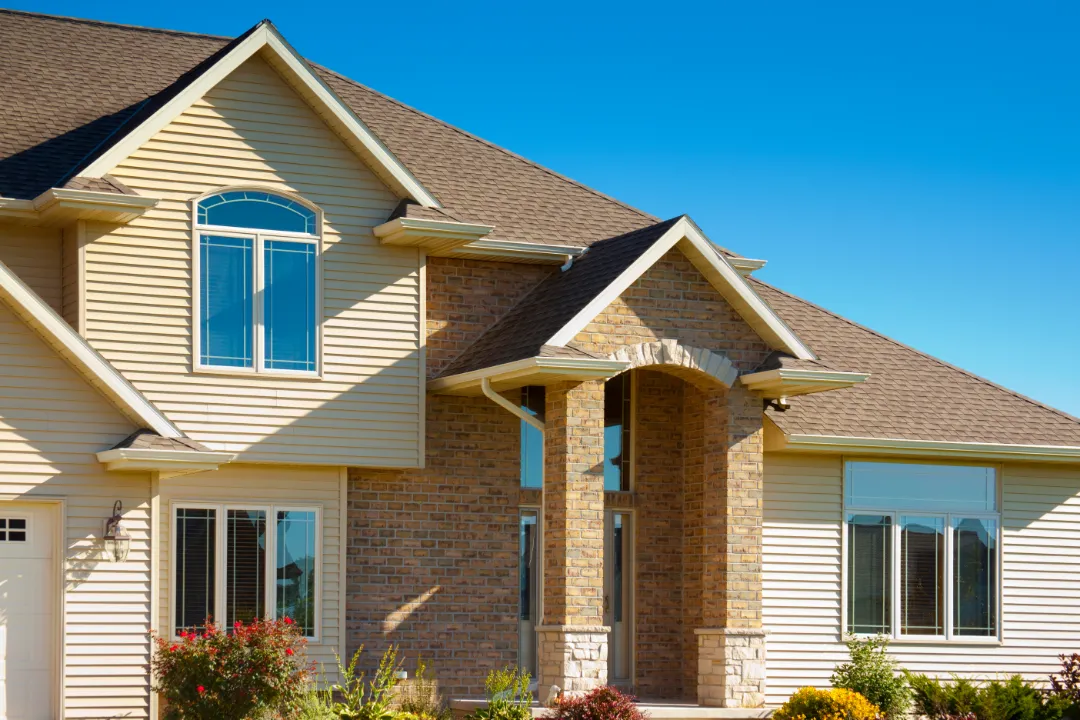Wesley Chapel Siding Blog
Welcome to Our Siding Contracting Services Blog

Vinyl Siding Installation: Your Comprehensive Guide
Vinyl siding is a popular choice for homeowners looking to improve their home's appearance and durability. We'll guide you through everything from preparation to installation, ensuring your project is a success. By following our comprehensive guide, you'll learn the ins and outs of installing vinyl siding, making it an enjoyable and rewarding experience.
Essential Preparation for Installing Vinyl Siding
Before beginning your vinyl siding project, it’s crucial to prepare properly. Ensuring the soffit and fascia are in good condition and understanding how fascia covers work are key steps to a successful installation. This preparation ensures a smooth and proper installation of vinyl siding.
Removing Old Materials and Preparing the Walls
Starting your vinyl siding project involves removing any old materials. Using a zip tool, we carefully take off existing vinyl siding panels and fix any loose boards. This step ensures the walls are ready for a fresh installation, laying the groundwork for a smooth process.
Considerations for New Construction vs. Re-siding
When installing vinyl siding, it's important to understand the differences between new construction and re-siding. New constructions offer a blank canvas, allowing for straightforward installation. However, re-siding requires careful removal of old materials and preparation of the surface to ensure the new siding adheres properly and lasts for years.
Materials Checklist for Vinyl Siding Installation
For a successful vinyl siding project, a comprehensive materials checklist is essential. Ensure you have a flat surface to work on, including starter strips, fascia covers, rigid foam for insulation, and hardie board for durability. These materials are vital for a quality installation.
Sheathing/Backerboard and Water-resistive Barriers
Installing a water-resistive barrier beneath the siding is crucial for protecting your home from moisture damage. This layer, combined with sheathing or backerboard, provides a solid, weather-resistant foundation for the vinyl siding, ensuring it remains both functional and aesthetic over time.
Nails, Screws, and Staples: Choosing the Right Fasteners
Choosing the right fasteners is critical for installing vinyl siding. We use corrosion-resistant nails for general siding, while aluminum or stainless steel fasteners are best for securing foam sheathing and aluminum trim pieces. Ensuring the fasteners are corrosion resistant and the nail heads are properly installed prevents future issues with your siding.
Step-by-Step Installation Process
The vinyl siding installation process involves meticulous steps, from measuring and cutting to fastening the panels. With the right tools and materials, including a focus on windows and doors, we ensure a seamless and efficient installation from start to finish.
Step 1: Measure and Estimate Materials Needed
Measuring your home accurately is the first step in installing vinyl siding. This includes considering any sliding glass doors and using a zip tool for precision. Estimating the right amount of vinyl siding panels ensures the project progresses smoothly without unnecessary delays.
Estimating Worksheet and Calculating Siding Panels
Using an estimating worksheet helps us calculate the exact amount of siding needed, including corner pieces installed. This meticulous planning ensures we have all necessary materials on hand, preventing any mid-project shortages and keeping the installation on schedule.
Step 2: Sheathing and Flashing for Moisture Control
Attaching sheathing directly to studs provides a sturdy base for the vinyl siding. We use foam plastic, plywood, or OSB to ensure the structure can withstand weather conditions, complemented by flashing for added moisture control.
Importance of Sheathing Nailability and Water-resistive Barriers
The nailability of sheathing is crucial for secure fastening of vinyl siding. Foam plastic sheathing offers an ideal surface for nails, ensuring a tight hold. Additionally, incorporating water-resistive barriers prevents moisture ingress, protecting your home's structural integrity.
Step 3: Fastening Procedure Explained
Proper fastening technique is vital for a successful siding project. By following specific procedures, we ensure the vinyl siding is securely attached to the home, providing durability and longevity.
Detailed Guidance on Nail, Screw, and Staple Use
When fastening vinyl siding, we carefully select the nail slot to allow for expansion and contract. Our professional approach ensures that the siding remains secure and aesthetically pleasing, even as temperature changes cause natural movements.
Step 4: Cutting the Siding with Precision
Cutting vinyl siding requires precision to ensure a perfect fit, especially around corner trim and rigid foam insulation. By using the right techniques and tools, we achieve clean, accurate cuts that contribute to the overall success of the siding project.
Techniques and Tools for Accurate Cuts
To make precise cuts in vinyl siding, having the right tools and techniques is crucial. A utility knife is perfect for scoring the siding, where a firm bend snaps it cleanly. For more intricate cuts, especially around windows and doors, tin snips are invaluable for their ability to shape the material as needed. Always measure twice and cut once, utilizing a straight edge or square to ensure accuracy. Remember, a zip tool will come in handy for adjustments around the nailing hem, allowing for a snug fit against the wall.
Foundation and Framework Installation
Before we dive into the main event, it's essential to lay a solid foundation. To install vinyl siding, the preparatory work cannot be overstated. It ensures that the siding will be mounted correctly and last for years. This stage sets the stage for a successful siding project by making sure everything is level and ready for the first piece of siding to be installed.
Step 5: Starter Strip Installation
Beginning our siding project on the right foot means installing the starter strip properly. It's the base upon which all other panels rest, so it needs to be level. We drive a nail at each end, then transfer the measurements and snap a chalk line to guide us. This ensures that every piece of siding will align perfectly, providing a visually appealing and structurally sound installation.
Key to a Level and Secured Siding Begin
The starter strip is not just a piece of metal; it's the foundation of our siding's integrity. By ensuring it's perfectly level and securely fastened, we set ourselves up for success. We pay close attention to the corners, where the corner trim will later connect, making sure they're flush and secure. This attention to detail here means fewer headaches later, as a well-laid start reduces cumulative errors.
Step 6: Install Inside & Outside Corner Posts
Once the foundation is set, we move on to the corner posts. Installing inside corner pieces and the vinyl soffit provides not just structural integrity but also adds to the aesthetic value of the home. These elements frame the house, giving it a finished look and ensuring that the corners are protected from the elements.
Ensuring Corner Integrity and Aesthetics
Corner trim is like the punctuation at the end of a sentence; it needs to be just right to make everything come together. When we install corner trim, we're not just thinking about how it looks now, but how it will withstand years of weather and wear. By securing it properly and ensuring it aligns with the siding and soffit, we guarantee both the integrity and the aesthetics of the home's corners for years to come.
Step 7: Attach Sheathing and Flashing for Weather Protection
To safeguard our homes against moisture, we first attach sheathing directly to studs, using either plywood or OSB. This layer is crucial for structural support. Next, we install flashing around windows and doors to direct water away, ensuring our homes stay dry and protected from the elements.
Installing the Main Siding Features
After preparing the surface, we focus on installing the main siding features. This involves working around existing siding and integrating new siding materials seamlessly with roofing to enhance both function and appearance.
Step 8: Soffit and Fascia - Meeting the Roofline
Our next step is to install soffit and fascia, which are key to linking the siding with the roofline. We carefully measure and cut soffit pieces, ensuring they fit perfectly into the nail slots of the J-channel, and secure them at the edges for a polished finish.
Harmonizing Siding with Roof Features
We aim to harmonize the siding with roof features by meticulously installing soffit and fascia. This not only enhances the home's aesthetic but also ensures it's properly protected from water damage. It's a detailed process that makes a big difference in the overall look and durability of the home.
Step 9: Dealing with Obstructions and Trim
Dealing with obstructions requires us to trim the existing siding to fit around any new features or changes. This step is crucial for a seamless appearance and functionality.
Techniques for Window, Door, and Other Trim Work
When it comes to windows and doors, we use precise cutting techniques to ensure the siding fits perfectly. This not only enhances the look but also improves the weatherproofing around these critical areas.
Step 10: Laying Down the Vinyl Siding Panels
With corner pieces installed, we start laying down pieces of siding. We install the siding lengthwise, accommodating expansion and ensuring that each length of siding wraps nicely around corners, using j-channels diagonally for a cohesive look.
Sequential Siding the Walls for a Cohesive Look
We focus on installing siding sequentially to ensure a cohesive look. This involves measuring and cutting each piece accurately, starting from the bottom and working our way up, ensuring corner pieces and fascia are aligned for a neat finish.
Final Touches and Maintenance Tips
After all main installations, we inspect around windows and doors, add utility trim, and ensure each row of siding is properly secured. Regular maintenance, including cleaning and inspections, will keep the siding in top condition for years.
Ensuring Proper Nailing and Fastening Throughout
We ensure nails or screws are corrosion resistant, spaced correctly, and not nailed too tightly to allow for the expansion and contraction of the siding. This prevents distortion and ensures horizontal siding panels remain secure and aesthetically pleasing.
Cutting and Fitting Siding Around Windows and Doors
When cutting vinyl siding, we always wear safety equipment. Precise cuts ensure the siding fits snugly around windows and doors, enhancing both the look and protection of the home.
Regular Inspection and Cleaning Recommendations
Regular inspection and cleaning are key to maintaining vinyl siding's appearance and longevity. We recommend a gentle cleaning schedule and periodic inspections to address any issues promptly, ensuring your home stays beautiful and protected.
Advanced Installation Insights
For those seeking to install vinyl siding, understanding the process and techniques involved can significantly impact the outcome of your project. Advanced insights can lead to better durability, especially in challenging climates.
Special Considerations for Coastal Areas
In coastal areas, the choice of materials and installation techniques can greatly affect the siding's resistance to wind and saltwater. Proper planning is essential.
Installation Techniques for High Wind Resistance
For areas prone to high winds, we adopt specialized installation techniques. This includes using specific fasteners and reinforcing areas of the siding to withstand the additional forces, ensuring the home's exterior remains intact and secure.
Creative Uses of Vinyl in Planned Communities
Vinyl siding is not just about durability; it's also about creativity and community aesthetics. In planned communities, we see vinyl being used in innovative ways to complement the architectural style and enhance the neighborhood's overall appeal. From vibrant colors that stand out to textures that mimic wood siding without the maintenance, vinyl offers versatility. This versatility allows communities to create unique and cohesive looks that reflect their identity and values.
Case Study: Enhancing Aesthetic Appeal and Durability
In a recent project, a planned community on the coast utilized vinyl siding to achieve a unified but diverse aesthetic across all homes, while ensuring high durability against the salty air. The project involved selecting premium vinyl siding with a wood grain texture to echo traditional coastal homes. This choice not only elevated the curb appeal of the entire community but also provided a low-maintenance solution resistant to the harsh coastal elements. The success of this case study highlights the potential of vinyl siding to meet both aesthetic and practical needs in community planning.
Wrapping Up Your Vinyl Siding Project
As we conclude our vinyl siding project, it's essential to reflect on the journey we've taken. From carefully selecting materials to meticulously installing each panel, our efforts have transformed the exterior of our home. The key steps, such as nailing the starter strip correctly and ensuring each siding panel aligns perfectly, have laid the foundation for a project we can be proud of. This process not only improves our home's appearance but also its protection against the elements, making our investment worthwhile.
Reviewing Installation Quality and Final Checklist
After installing vinyl siding, reviewing the work is crucial to ensure quality. Inspect each section closely, paying special attention to areas around exterior doors and windows, as these are common points for mistakes. Use our final checklist to verify that all panels are securely fastened, the siding is free of gaps, and the trim work is neatly done. This step is vital for guaranteeing the longevity and effectiveness of the siding in protecting your home.
Maintenance Schedule for Long-lasting Siding
Maintaining your vinyl siding is key to its longevity. We recommend a simple maintenance schedule that includes regular cleaning with mild soap and water, an annual inspection to check for any damages or loose panels, and prompt repairs if necessary. This routine helps preserve the siding's appearance and functionality, ensuring your home continues to be protected and looks great year after year. By following these maintenance tips, you can enjoy the benefits of your vinyl siding for decades.
Summing Up Your Siding Success
Our journey through the vinyl siding installation process has not only enhanced our home's curb appeal but also its overall value. By empowering ourselves with knowledge and the right skills, we've successfully navigated the complexities of vinyl siding installation. This project has taught us the importance of attention to detail, from preparation to the finishing touches. As we look at our home's transformed exterior, we're reminded of the value of investing time and effort into our living spaces.
Empowering Homeowners Through Knowledge and Skill
Understanding the intricacies of vinyl siding installation empowers us as homeowners. By learning from resources like the Vinyl Siding Institute, we ensure our projects meet high standards of quality and durability. This knowledge not only guides us through the installation process but also helps us make informed decisions for our homes.
Reflecting on the Journey from Preparation to Perfection
Looking back on the installation process, from the initial planning stages to the final touches, our journey with vinyl siding has been one of learning and achievement. We've seen firsthand how preparation, precise execution, and regular maintenance can lead to perfection. This experience has not only beautified our home but also strengthened it against the elements, ensuring that our efforts will stand the test of time.
© Copyright 2025 Wesley Chapel Siding. All Rights Reserved.
Terms & Conditions | Privacy Policy
Zip codes we serve: 33543,33545,33544,33647,33559,33541,34639,33576,33592,33539,33574,33542,33549,33524,34637,33540,33613,33548,33525,33637,33620,33617,3355833543,33545,33544,33647,33559,33541,34639,33576,33592,33539,33574,33542,33549,33524,34637,33540,33613,33548,33525,33637,33620,33617,33558

